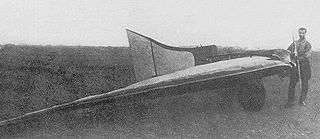Related Research Articles

The Mikoyan-Gurevich I-270 was a response to a Soviet Air Forces requirement in 1945 for a rocket-powered interceptor aircraft for the point-defence role. In concept and basic configuration, it was related to the early Korolyov RP-318 rocket-powered aircraft which was developed in 1936 and first flew February 20, 1940, and the more recent Bereznyak-Isayev BI-1 Soviet design. Only two prototypes were built, both of which were destroyed in crashes, leading to the cancellation of the project.
The Bisnovat 5 was a supersonic research aircraft designed in the USSR in the late 1940s, inspired by the German DFS 346 aircraft that was captured by Soviet troops towards the end of World War II.
The Tupolev Tu-91 was a Soviet carrier-borne attack aircraft. It was built only in prototype form, and was converted into a land-based aircraft after Joseph Stalin's death in 1953 cancelled the aircraft carriers being designed.

The Yakovlev UT-2 was a single-engine tandem two-seat low-wing monoplane that was the standard Soviet trainer during the Great Patriotic War. It was used by the Soviet Air Force from 1937 until replaced by the Yakovlev Yak-18 during the 1950s.

The Yakovlev UT-1 was a single-seater trainer aircraft used by the Soviet Air Force from 1937 until the late 1940s.

The Yakovlev Yak-112 Filin (Owl) is a Russian/Soviet civil utility aircraft that first flew in 1992. It is an all-metal high-wing strut braced monoplane with fixed tricycle landing gear.
The Beriev Be-8, was built by the Soviet Beriev OKB in 1947. It was a passenger/liaison amphibian aircraft with a layout similar to the Be-4 but substantially larger and heavier. It was a single engined parasol winged aircraft, with the wing installed on a thin pylon and a pair of short struts. Compared to the Be-4, the Be-8 was equipped with retractable landing gear, with cockpit and passenger cabins heated by an engine exhaust heat exchanger. The Be-8 was intended as a civil aircraft and carried no armament. First flight was on 3 December 1947, demonstrating good performance and of the two prototypes, one was demonstrated during the 1951 Soviet Aviation Day at Tushino.

The Bereznyak-Isayev BI-1 was a Soviet short-range rocket powered interceptor developed during the Second World War.

The Yakovlev Yak-6 was a Soviet twin-engined utility aircraft, developed and built during World War II. It was used as a short-range light night bomber and a light transport.
The Tupolev MTB-1 was a patrol flying boat built in the Soviet Union in the mid-1930s. It was a refined version of the unsuccessful Chyetverikov MDR-3. The revised design retained the MDR-3's hull, but added a newly designed, full-cantilever wing, a new tail, and a new engine installation featuring two tractor and one pusher unit. Trials began in March 1934 but the prototype was destroyed during one takeoff.

The Tupolev ANT-22 was a large flying boat built in the Soviet Union in 1934. A huge aircraft consisting of two hulls and powered by six engines in three nacelles in a push-pull configuration, it was based on the ANT-11, which was never built. Its enormous weight severely crippled its performance, and it never proceeded beyond the experimental stage.
The Nikitin PSN-1 was a piloted glider anti-shipping missile produced in the USSR from 1937.
The Belyayev Babochka, was a tandem seat research aircraft designed in the USSR from 1939.
The SK-1,, was a research aircraft designed and built in the USSR from 1938.
The LEM-3,, was a transport aircraft designed and built in the USSR from 1936.
The I-218 was an attack aircraft designed and built in the USSR from 1947.

The BICh-3 was a tailless research aircraft designed and built in the USSR in 1926.
The BICh-11 was a twin-engined tailless research aircraft designed and built in the USSR from 1931.
The Gribovsky G-28 was an advanced trainer for trainee fighter pilots, built in the USSR just before the German invasion in 1941. It satisfied VVS testing but changing priorities led to the abandonment of production plans.

Reactive Scientific Research Institute was one of the first Soviet research and development institutions to focus on rocket technology. RNII developed the Katyusha rocket launcher and its research and development were very important for later achievements of the Soviet rocket and space programs.
References
- ↑ Gunston 1995, p. 159
- Gunston, Bill (1995). The Osprey Encyclopedia of Russian Aircraft 1875–1995. London: Osprey. ISBN 1-85532-405-9.